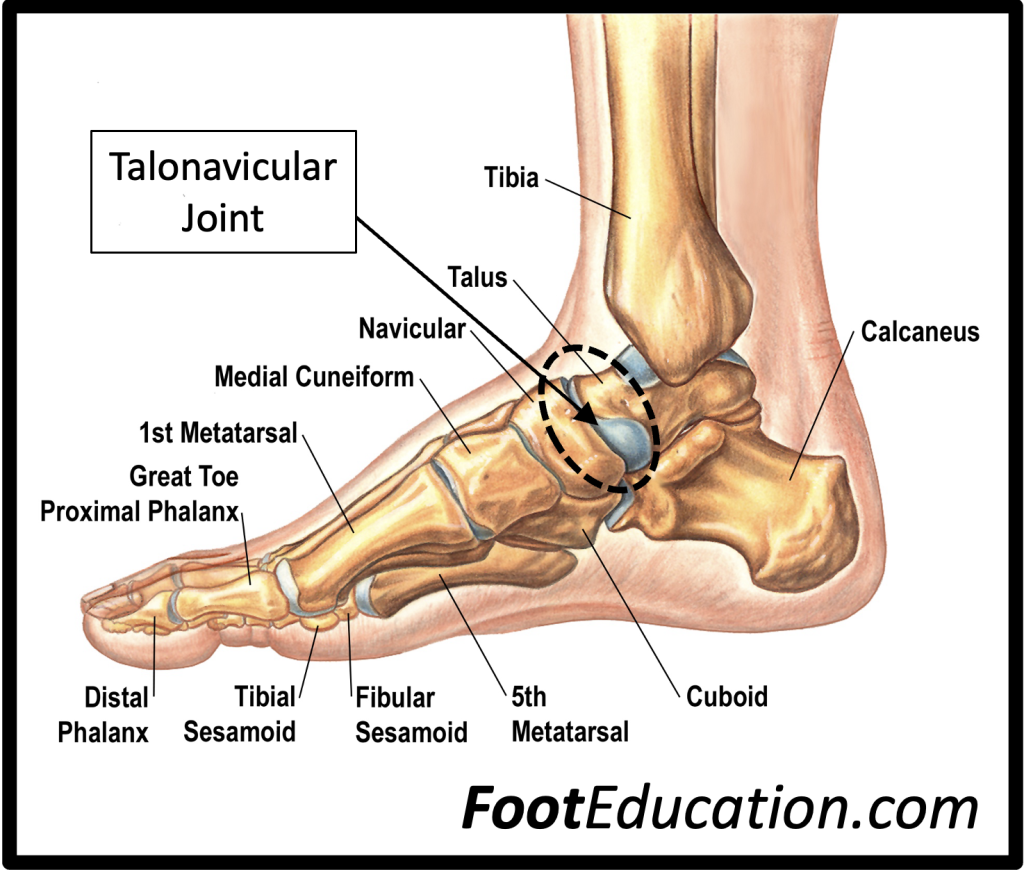Talonavicular Arthritis
Talonavicular arthritis occurs when the cartilage in the talonavicular joint is lost leading to arthritis which causes stiffness and pain.The talonavicular joint is a joint formed by the talus, and the foot bone immediately in front of it called the navicular (Figure 1). The talonavicular joint is critical in allowing the foot to move inwards and outwards, as well as in a circular motion. Talonavicular arthritis can be caused by a variety of conditions including trauma to the joint; degeneration over time, history of an untreated navicular stress fracture, or due to inflammation from a disease such as rheumatoid arthritis.

Physical Exam and Symptoms of Talonavicular Arthritis
On routine physical exam, motion is often severely limited through the hindfoot, particularly when assessing side-to-side (inversion-eversion) or rotational movement. There may also be swelling or bogginess in the foot just below the front of the ankle as well as along the inner aspect of the arch of the foot. Patients will frequently have direct tenderness to palpation along the top (dorsal) and inside (medial) aspect of the hindfoot. Other surrounding joints may also be affected causing additional tenderness and pain.
Imaging Studies
X-rays are helpful in diagnosing this condition. As the cartilage wears out in the joint, the space seen on x-ray between the talus and navicular bone narrows and bone spurs may form (Figure 2).

Labwork
If the arthritis in the talonavicular joint is simply due to wear and tear or trauma, lab tests are often normal. Patients suffering from rheumatoid arthritis or related immune system disorders will often exhibit abnormal lab values on blood tests, such as a positive “rheumatoid factor.” Seeking out the results of such labwork may help confirm the diagnosis of rheumatoid arthritis if it is in question.
Treatment of Talonavicular Arthritis
Conservative Treatment
Similar to arthritis in other joints of the foot a variety of conservative treatments can help improve symptoms, although the arthritis remains. Common conservative treatments of talonavicular arthritis include:
- Comfort shoes can be helpful in the treatment of this condition. A stiff sole or shank will prevent painful motion
- Activity modification will also be helpful. A stretching program to the back of the calf can decrease excessive stress through overworked joints.
- Weight loss to decrease the force going through this area of the foot will be beneficial, though exercise can be difficult with a painful foot or ankle.
- Bracing can be helpful by preventing the in and out movement generally associated with a talonavicular joint.
- Management of other medical conditions including rheumatoid arthritis may also be helpful.
- Corticosteroid injections performed under fluroscopy or ultrasound can provide considerable improvement in the short and intermediate term.
Surgical Treatment
When the talonavicular joint wears out to the point where the bones rubbing create significant pain, and other measures fail, one may consider fusing the talus and navicular together. This procedure is called a talonavicular fusion or talonavicular arthrodesis. When successful this fusion surgery will eliminate pain orginating from the arthritic talonavicular joint, although there may still be pain that originates from other areas of the foot. The procedure does, however, restrict future motion from that joint and this can make the foot somewhat stiffer—but few patients consider this an issue given the excellent long term pain relief that can be expected from this operation. For more detailed information of a talonavicular fusion click on the link.
Edited November 13th, 2024